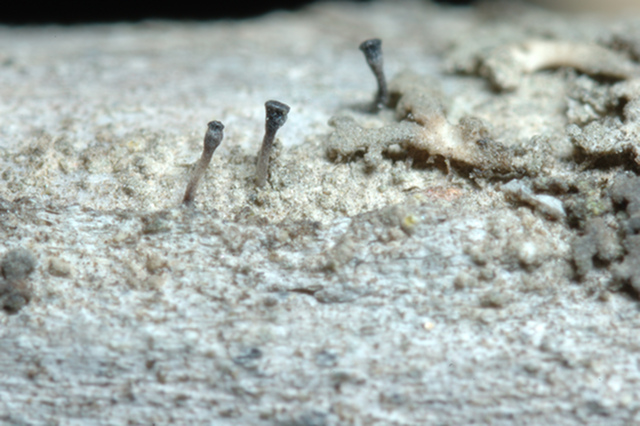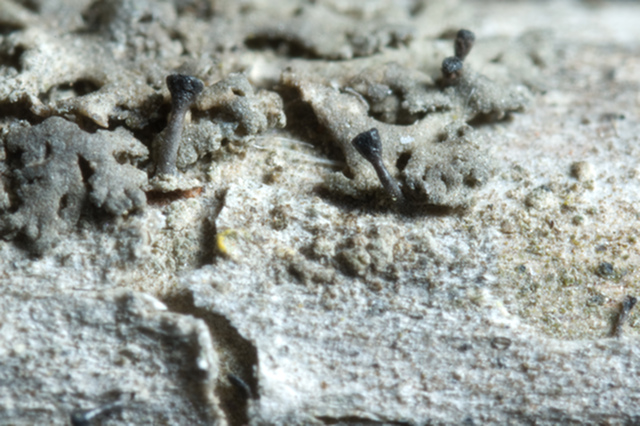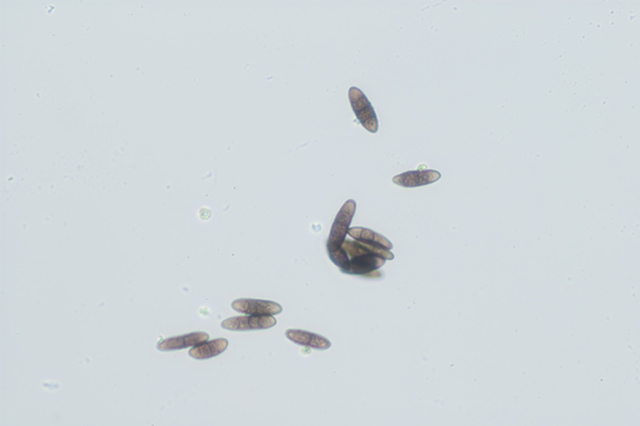- HOME
- Introduction
- History of "Caliciales" and the Origin of the "Calicioids"
- Biogeography of Calicioids
- Calicioid Ecology and Habitats
- Conservation
- Zen and the Search for Calicioids
- Collecting and Curating
- Key to Genera
- Acolium
- Acroscyphus
- Allocalicium
- Bruceomyces
- Calicium
- Chaenotheca
- Chaenothecopsis
- Cyphelium
- Cryptocalicium
- Microcalicium
- Mycocalicium
- Phaeocalicium
- Pseudothelomma
- Sclerophora
- Sphinctrina
- Stenocybe
- Texosporium
- Thelomma
- Tholurna
- "Within-bark"
- Glossary
- References
0.01 (development)
Eric B. Peterson
Phaeocalicium
Phaeocalicium is anatomically close to Stenocybe. About the only distinction that has been maintained in the literature is the spore size: Less than 20 μm for Phaeocalicium, mostly geater than 20 μm for Stenocybe (except for S. pullatula and the smaller spores of S. procrastinata - although the later almost always has plenty that are greater than 20 μm; see Peterson 2021). Distinguishing genera only by spore size seems artificial and I suggest spore shape and spore wall characters may be of greater use. Most species of Stenocybe are more pointed than in Phaeocalicium (although the type species for Stenocybe has spores with rounded ends in my experience). Stenocybe spores also tend to have pale apices and perhaps different wall structure. It is possible that there ought to be three: spores with dark, rounded end; spores with pale, rounded ends, and spores with distinctly pointed ends. These need to be carefully examined along with phylogenetic analysis in order to sort these genera out.
Taxa covered (22):
Phaeocalicium "parvispora"
Phaeocalicium acadiae
Phaeocalicium ahtii
Phaeocalicium asciiforme
Phaeocalicium betulinum
Phaeocalicium boreale
Phaeocalicium compressulum
Phaeocalicium curtisii
Phaeocalicium flabelliforme
Phaeocalicium fuegensis Tibell
Phaeocalicium gracile
Phaeocalicium interruptum
Phaeocalicium matthewsianum
Phaeocalicium minutissimum
Phaeocalicium ornicolum
Phaeocalicium pinaceum
Phaeocalicium polyporaeum
Phaeocalicium populneum
Phaeocalicium praecedens
Phaeocalicium tibetanicum
Phaeocalicium tremulicola
Key to Species
Validation script believes the following taxa are missing from the keys:
- Phaeocalicium "parvispora"
- Phaeocalicium acadiae
- Phaeocalicium ahtii
- Phaeocalicium fuegensis Tibell
- Phaeocalicium gracile
- Phaeocalicium matthewsianum
- Phaeocalicium minutissimum
- Phaeocalicium ornicolum
- Phaeocalicium pinaceum
-
-
- 3a. Excipulum with an outer layer of small, isodiametric cells, spores pale brown, smooth.Phaeocalicium betulinum
- 3b. Excipulum consisting of periclinally arranged hyphae, without isodiametric cells. Spores dark brown, with a minute ornamentation.Phaeocalicium compressulum
- 2b. Capitula not strongly flattened, though possibly with some flat areas resulting in a ca. 5-7 sided polygon in cross section.
- 4a. Excipulum rim distinctly thickened, ascomata 0.3 - 0.4mm high. Growing on Fraxinus, Populus, and Salix.Phaeocalicium interruptum
-
- 5a. Spores reliably < 10μm long. Ascomata < 0.25mm tall. Known only from a single collection on Alnus in western North America.Phaeocalicium "parvisporum"
-
- 6a. On Populus, ascomata 0.6- 0.9mm high, often K+G.Phaeocalicium praecedens
- 6b. On Fraxinus (+Quercus?), ascomata less than 0.5 mm high, K reaction various - may represent several spp., though still being studies - it may also represent variation within P. interruptum.Phaeocalicium "fraxinea"
-
-
-
- 8a. Spores 3 septate.Phaeocalicium fuegensis
-
- 9a. Stalk brownish when sectioned, excipulum 11 - 13μm thick, known only from Betula in northern Sweden.Phaeocalicium flabelliforme
- 9b. Stalk in section aeruginose (greenish), excipulum 20 - 25μm thick, known only from decaying branches of Coprosma in New Zealand.Phaeocalicium asciiforme
- 7b. Capitula not strongly flattened, though possibly with some flat areas resulting in a ca. 5-7 sided polygon in cross section.
- 10a. On polypore (note: Chaenotheca brunneola and Chaenothecopsis caespitosa have also been found on polypores).Phaeocalicium polyporaeum
-
- 11a. On stems and large branches of Rhus typhina.Phaeocalicium curtisii
-
-
- 13a. Ascospores 12 - 21μm long.Phaeocalicium tibetanicum
- 13b. Ascospores shorter.Phaeocalicium populneum
- 12b. Ascomata 0.3-0.4 mm high, excipulum consisting of isodiametric or periclinally arranged cells, on various hardwoods.
- 14a. Excipulum edge strongly thickened, spores 9-11 X 4-4.5 μm.Phaeocalicium interruptum
-
- 15a. Excipulum and stalk reddish in section, K+ intensified reddish, stalk finally dark reddish grey.Phaeocalicium boreale
-
- 16a. Excipulum and stalk pale, brownish or greenish brown in section, K-.Phaeocalicium "fraxinea"
-
- 17a. Mature spores with heavily pigmented septa, excipulum consisting of a single layer of isodiametric cells with thick walls 5-6 μm wide.Phaeocalicium tremulicola
- 17b. Mature spores with poorly pigmented septa, excipulum consisting of 2-3 layers of sclerotized, periclinally arranged hyphae.Stenocybe pullatula
-
-
Species Details
ID=162
Type(s):
may be P. interruptum ? needs further study
Synonyms:
Habit and Morphology:
Anatomy:
Chemistry:
Habitat:
Biogeography:
Global Rank:
Conservation:
Notes:
External Information:
 Index Fungorum: ID=
Index Fungorum: ID= Encyclopedia of Life (EOL): Search
Encyclopedia of Life (EOL): Search - CNALH: Search
- NatureServe:
 ODBaL Search
ODBaL SearchNucleotide Search
ID=169
Type(s):
Synonyms:
Habit and Morphology:
Anatomy:
Chemistry:
Habitat:
Biogeography:
Global Rank:
Conservation:
Notes:
External Information:
 Index Fungorum: ID=
Index Fungorum: ID= Encyclopedia of Life (EOL): Search
Encyclopedia of Life (EOL): Search - CNALH: Search
- NatureServe:
 ODBaL Search
ODBaL SearchNucleotide Search
ID=153
Type(s): listed in Tibell?s checklist (?99), ?NAm?
Synonyms:
Habit and Morphology:
Anatomy:
Chemistry:
Habitat:
Biogeography:
Global Rank:
Conservation:
Notes:
External Information:
 Index Fungorum: ID=
Index Fungorum: ID= Encyclopedia of Life (EOL): Search
Encyclopedia of Life (EOL): Search - CNALH: Search
- NatureServe:
 ODBaL Search
ODBaL SearchNucleotide Search
ID=189
Type(s):
Synonyms:
= Stenocybe ahtii Titov & Baibul.
Habit and Morphology:
Anatomy:
Chemistry:
Habitat:
Biogeography:
Global Rank:
Conservation:
Notes:
External Information:
 Index Fungorum: ID=
Index Fungorum: ID= Encyclopedia of Life (EOL): Search
Encyclopedia of Life (EOL): Search - CNALH: Search
- NatureServe:
 ODBaL Search
ODBaL SearchNucleotide Search
ID=155
Type(s): -1987
Synonyms:
Habit and Morphology:
Anatomy:
Chemistry:
Habitat:
Biogeography:
Global Rank:
Conservation:
Notes:
External Information:
 Index Fungorum: ID=
Index Fungorum: ID= Encyclopedia of Life (EOL): Search
Encyclopedia of Life (EOL): Search - CNALH: Search
- NatureServe:
 ODBaL Search
ODBaL SearchNucleotide Search
ID=156
Type(s):
Synonyms:
Habit and Morphology:
Anatomy:
Chemistry:
Habitat:
Biogeography:
Global Rank:
Conservation:
Notes:
External Information:
 Index Fungorum: ID=
Index Fungorum: ID= Encyclopedia of Life (EOL): Search
Encyclopedia of Life (EOL): Search - CNALH: Search
- NatureServe:
 ODBaL Search
ODBaL SearchNucleotide Search
ID=157
Type(s): -1996
Synonyms:
Habit and Morphology:
Anatomy:
Chemistry:
Habitat:
Biogeography:
Global Rank:
Conservation:
Notes:
External Information:
 Index Fungorum: ID=
Index Fungorum: ID= Encyclopedia of Life (EOL): Search
Encyclopedia of Life (EOL): Search - CNALH: Search
- NatureServe:
 ODBaL Search
ODBaL SearchNucleotide Search
ID=159
Type(s):
Synonyms:
Habit and Morphology:
Anatomy:
Chemistry:
Habitat:
Biogeography:
Global Rank:
Conservation:
Notes:
External Information:
 Index Fungorum: ID=
Index Fungorum: ID= Encyclopedia of Life (EOL): Search
Encyclopedia of Life (EOL): Search - CNALH: Search
- NatureServe:
 ODBaL Search
ODBaL SearchNucleotide Search
ID=160
Type(s):
Synonyms:
Habit and Morphology:
Anatomy:
Chemistry:
Habitat:
Biogeography:
Global Rank:
Conservation:
Notes:
External Information:
 Index Fungorum: ID=
Index Fungorum: ID= Encyclopedia of Life (EOL): Search
Encyclopedia of Life (EOL): Search - CNALH: Search
- NatureServe:
 ODBaL Search
ODBaL SearchNucleotide Search
ID=161
Type(s):
-1996
Synonyms:
Habit and Morphology:
Anatomy:
Chemistry:
Habitat:
Biogeography:
Global Rank:
Conservation:
Notes:
External Information:
 Index Fungorum: ID=
Index Fungorum: ID= Encyclopedia of Life (EOL): Search
Encyclopedia of Life (EOL): Search - CNALH: Search
- NatureServe:
 ODBaL Search
ODBaL SearchNucleotide Search
ID=163
Type(s):
Synonyms:
Habit and Morphology:
Anatomy:
Chemistry:
Habitat:
Biogeography:
Global Rank:
Conservation:
Notes:
External Information:
 Index Fungorum: ID=
Index Fungorum: ID= Encyclopedia of Life (EOL): Search
Encyclopedia of Life (EOL): Search - CNALH: Search
- NatureServe:
 ODBaL Search
ODBaL SearchNucleotide Search
ID=164
Type(s): (2006): Titov 2006
Synonyms:
Habit and Morphology:
Anatomy:
Chemistry:
Habitat:
Biogeography:
Global Rank:
Conservation:
Notes:
External Information:
 Index Fungorum: ID=
Index Fungorum: ID= Encyclopedia of Life (EOL): Search
Encyclopedia of Life (EOL): Search - CNALH: Search
- NatureServe:
 ODBaL Search
ODBaL SearchNucleotide Search
ID=165
Type(s):
Synonyms:
Habit and Morphology:
Anatomy:
Chemistry:
Habitat:
Biogeography:
Global Rank:
Conservation:
Notes:
External Information:
 Index Fungorum: ID=
Index Fungorum: ID= Encyclopedia of Life (EOL): Search
Encyclopedia of Life (EOL): Search - CNALH: Search
- NatureServe:
 ODBaL Search
ODBaL SearchNucleotide Search
ID=166
Type(s):
Synonyms:
Habit and Morphology:
Anatomy:
Chemistry:
Habitat:
Biogeography:
Global Rank:
Conservation:
Notes:
External Information:
 Index Fungorum: ID=
Index Fungorum: ID= Encyclopedia of Life (EOL): Search
Encyclopedia of Life (EOL): Search - CNALH: Search
- NatureServe:
 ODBaL Search
ODBaL SearchNucleotide Search
ID=167
Type(s):
(still under Stenocybe in my key)
Synonyms:
Habit and Morphology:
Anatomy:
Chemistry:
Habitat:
Biogeography:
Global Rank:
Conservation:
Notes:
External Information:
 Index Fungorum: ID=
Index Fungorum: ID= Encyclopedia of Life (EOL): Search
Encyclopedia of Life (EOL): Search - CNALH: Search
- NatureServe:
 ODBaL Search
ODBaL SearchNucleotide Search
ID=168
Type(s): Titov 2006
Synonyms:
Habit and Morphology:
Anatomy:
Chemistry:
Habitat:
Biogeography:
Global Rank:
Conservation:
Notes:
External Information:
 Index Fungorum: ID=
Index Fungorum: ID= Encyclopedia of Life (EOL): Search
Encyclopedia of Life (EOL): Search - CNALH: Search
- NatureServe:
 ODBaL Search
ODBaL SearchNucleotide Search
ID=170
Type(s): (1986): Titov 2006
Synonyms:
Habit and Morphology:
Anatomy:
Chemistry:
Habitat:
Biogeography:
Global Rank:
Conservation:
Notes:
External Information:
 Index Fungorum: ID=
Index Fungorum: ID= Encyclopedia of Life (EOL): Search
Encyclopedia of Life (EOL): Search - CNALH: Search
- NatureServe:
 ODBaL Search
ODBaL SearchNucleotide Search
ID=171
Type(s):
Synonyms:
Habit and Morphology:
Anatomy:
Chemistry:
Habitat:
Biogeography:
Global Rank:
Conservation:
Notes:
External Information:
 Index Fungorum: ID=
Index Fungorum: ID= Encyclopedia of Life (EOL): Search
Encyclopedia of Life (EOL): Search - CNALH: Search
- NatureServe:
 ODBaL Search
ODBaL SearchNucleotide Search
ID=172
Type(s):
Synonyms:
Habit and Morphology:
Anatomy:
Chemistry:
Habitat:
Biogeography:
Global Rank:
Conservation:
Notes:
External Information:
 Index Fungorum: ID=
Index Fungorum: ID= Encyclopedia of Life (EOL): Search
Encyclopedia of Life (EOL): Search - CNALH: Search
- NatureServe:
 ODBaL Search
ODBaL SearchNucleotide Search
ID=173
Type(s):
Synonyms:
Habit and Morphology:
Anatomy:
Chemistry:
Habitat:
Biogeography:
Global Rank:
Conservation:
Notes:
External Information:
 Index Fungorum: ID=
Index Fungorum: ID= Encyclopedia of Life (EOL): Search
Encyclopedia of Life (EOL): Search - CNALH: Search
- NatureServe:
 ODBaL Search
ODBaL SearchNucleotide Search
ID=174
Type(s): (2000):
Synonyms:
Habit and Morphology:
Anatomy:
Chemistry:
Habitat:
Biogeography:
Global Rank:
Conservation:
Notes:
External Information:
 Index Fungorum: ID=
Index Fungorum: ID= Encyclopedia of Life (EOL): Search
Encyclopedia of Life (EOL): Search - CNALH: Search
- NatureServe:
 ODBaL Search
ODBaL SearchNucleotide Search
ID=175
Type(s): (see Tibell 1996 - comb. nov.)
Synonyms:
Habit and Morphology:
Anatomy:
Chemistry:
Habitat:
Biogeography:
Global Rank:
Conservation:
Notes:
External Information:
 Index Fungorum: ID=
Index Fungorum: ID= Encyclopedia of Life (EOL): Search
Encyclopedia of Life (EOL): Search - CNALH: Search
- NatureServe:
 ODBaL Search
ODBaL SearchNucleotide Search
Count of taxa = 22






